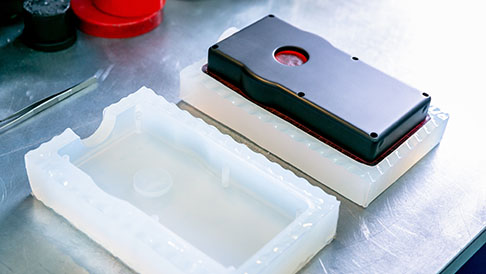Method of silicone mold making
Silicone mold making is the simplest way of rapid prototype. Generally, a prototype will be printed by 3D printers and then vacuum casted. However, the mold life is very short, only about 10-40 pieces. It has good elasticity and reproducibility, and no need to consider the draft angle. It has good separability, which can be directly poured as a whole without dividing the upper mold and the lower mold, then cut along the predetermined parting line, and then take out the master mold.

The following are the specific steps:
1. Stir the silicone and curing agent evenly. The appearance of the mold is flowing liquid. Component A is silicone and component B is curing agent. For example, take 100 grams of silicone and add 2 grams of curing agent (Note: siliconel and curing agent must be stirred evenly. If not, the curing and drying of the mold will be uneven, which will affect the service life and turnover of the mold, and even cause the mold to be scrapped.
2. Vacuumizing and removing bubbles.The time of vacuumizing should not be too long, generally not more than 10 minutes, otherwise, the curing of silicone will have cross-linking reaction, which will result in the waste of materials.
3. Brushing process. Pour the cilicone that has been discharged with bubbles on the master mold by brushing or pouring (before brushing or pouring, put isolation agent or release agent on the master mold), brush the mold evenly, and stick a layer of cloth or glass fiber cloth after 30 minutes to increase the strength and tension of the mold; Second brushing, then sticking a layer of cloth or glass fiber cloth, and then brushing with silicone. The mold treated in this way has the advantages of long service life, which has low cost and high benefit.
4. Manufacture of external mold. The general method is: surround the mold with plastic or wooden boards. One method is to fill the mold frame with plaster, and the other is to coat the outer mold with resin, coating a layer of resin, then glass fiber cloth, and repeating two or three layers to finish the outer mold.
Matters needing attention and solutions of bubbles during mold making:
Matters needing attention:
1. component b is a catalyst, which is easily hydrolyzed by moisture, so the cover should be tightly closed after use.
2. Once the components A and B are mixed, the chemical reaction starts immediately, and the viscosity gradually rises, so it can't be stopped. To avoid waste, it should be prepared according to the dosage, and it should be used immediately without delay.
3. The mixture ratio of component A and B is related to the speed of chemical reaction and the performance of the mold. The more components B, the faster the reaction, the higher the strength and hardness of the product, but the lower the toughness. Therefore, accurate weighing is required.
4. Before mixing, the ingredients of component A should be stirred evenly up and down, and then weighed.
5. For the mold for pouring relief, the frame whose length and width are 4-6CM larger than those of the original sculpture should be made first. The border should be straight and the inside should be smooth. When pouring, place the frame on a clean glass plate, and then place the prototype in the frame, leaving a gap of 2-3CM on each side.
Solutions to bubbles in the process of making silicone mold;
- Improve the design of flash groove and exhaust system;
- Increase the pressure of the press;
- Reduce the dosage of release agent and spray it evenly;
- Control water content of materials;
- Ty to add some defoamers;
- Using cold runner;
- Vacuum pumping with a vacuum machine, and an exhaust groove can be added to the mold.

